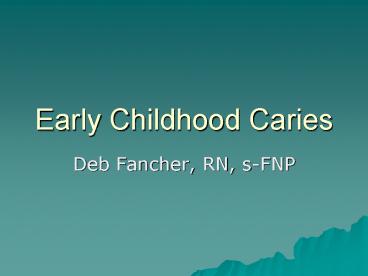Early Childhood Caries - PowerPoint PPT Presentation
1 / 12
Title: Early Childhood Caries
1
Early Childhood Caries
- Deb Fancher, RN, s-FNP
2
Who?WHO?American Indians (AI)Alaska
Natives (AN)Children in these populations lt 6
years old
3
What?
- Early Childhood Caries (ECC)
- Severe Early Childhood Caries (S-ECC)
- Some require general anesthesia to rehabilitate
restorations or extractions - (Schroth, r. et al, 2009)
4
Where?
- Rural and remote indigenous citizens
- Alaskan native populations
- American Indian populations
5
When?
- 1999 Indian Health Services Survey
- 2663 AI-AN preschool children examined
- 79 ECC (Schroth,R. et al, 2009)
- WWII sucrose largely unavailable, caries
decreased in all populations - (YoungDentist, date unavail.)
6
Why?
- Multifactorial
- Access to dental care (geographical isol.)
- Socioeconomic status
- Increased intake sucrose
- Incidence of caries has increased at about same
rate as rising sucrose consumption - (YoungDentist, date unavail.)
7
Why? (cont)
- Oral health literacy
- Oral hygeine
- Environmental factors
- Fluoride exposure
- Water fluoridation
- Community support
- Social determinantscritical role in
susceptibility - (Schroth, R. et al, 2009)
8
How Much?
- 2-4 y.o. 5 x general population
- Untreated caries 3 x general population
- Minor percentage access dental care offered by
Indian Health Services (HIS) - (Schroth, R. et al., 2009)
9
How does this relate to us?
- Holistic
- Possible correlation dental caries and failure
to thrive - ECC children with otitis media (OM)
- Higher incidence of OM
- Chewing/eating behaviors
- Quality of life Sleep? Pain? Behavior?
- (Schroth, R. et al., 2009)
10
How does this relate to us? (cont.)
- Anticipatory Guidance change behaviour no baby
bottles after age 12 months - Adopt new behavior regular tooth brushing
- Encourage remineralization of tooth
enamelfluoride - Encourage expectant moms in healthy diet and oral
hygeine - Voice of leaders within communities will more
likely lead to change - (Schroth, R.et al., 2009)
11
Primary Care Providers
- Screen
- Refer
- Encourage dental home by 12 months
- Counsel fluoride interventions, varnish (Crane,
M, 2011) - Lobby for greater dental care access in remote
regions (Schroth, R. et al, 2009)
12
References
- Crane, M. (2011). Improving kids teeth their
goal. Columbus Dispatch newspaper, May 22, 2011. - Schroth, R., Dahl, P., Haque, M., Kliewer, E.
(2009). Early childhood caries among Hutterite
preschool children in Manitoba, Canada. Rural
Remote Health. 10(4), 1-11. - YoungDentist (n.d.). The most common disease that
causes loss of teeth-Dental caries part 5.
Retrieved June 10, 2011 from http//www.sanedentis
t.com/the-most-common-disease-that-causes-loss-of-
teeth-dental-caries.html.

